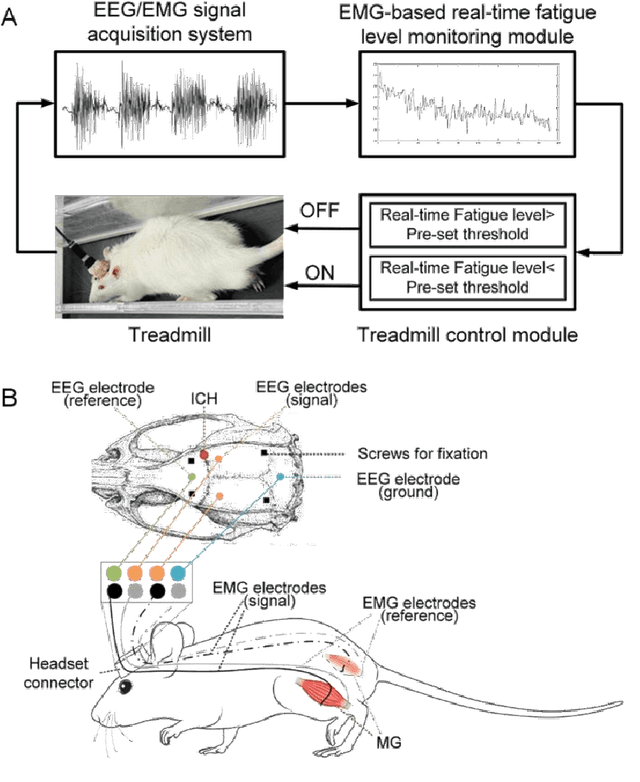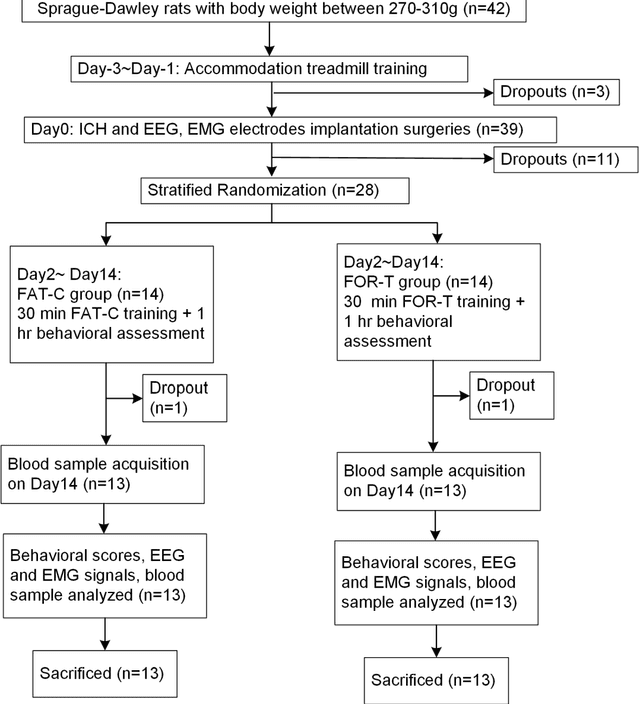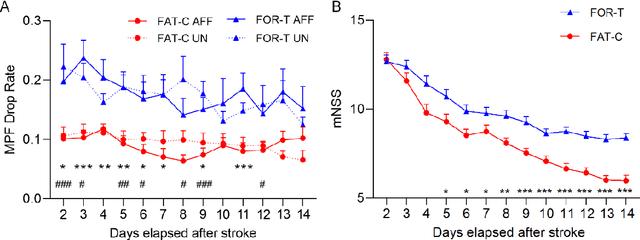Minmin Wang
Key Laboratory of Biomedical Engineering of Ministry of Education, Qiushi Academy for Advanced Studies, Zhejiang University, China, Westlake Institute for Optoelectronics, Westlake University, China
Poststroke rehabilitative mechanisms in individualized fatigue level-controlled treadmill training -- a Rat Model Study
Feb 20, 2025



Abstract:Individualized training improved post-stroke motor function rehabilitation efficiency. However, the mechanisms of how individualized training facilitates recovery is not clear. This study explored the cortical and corticomuscular rehabilitative effects in post-stroke motor function recovery during individualized training. Sprague-Dawley rats with intracerebral hemorrhage (ICH) were randomly distributed into two groups: forced training (FOR-T, n=13) and individualized fatigue-controlled training (FAT-C, n=13) to receive training respectively from day 2 to day 14 post-stroke. The FAT-C group exhibited superior motor function recovery and less central fatigue compared to the FOR-T group. EEG PSD slope analysis demonstrated a better inter-hemispheric balance in FAT-C group compare to the FOR-T group. The dCMC analysis indicated that training-induced fatigue led to a short-term down-regulation of descending corticomuscular coherence (dCMC) and an up-regulation of ascending dCMC. In the long term, excessive fatigue hindered the recovery of descending control in the affected hemisphere. The individualized strategy of peripheral fatigue-controlled training achieved better motor function recovery, which could be attributed to the mitigation of central fatigue, optimization of inter-hemispheric balance and enhancement of descending control in the affected hemisphere.
Ascend HiFloat8 Format for Deep Learning
Sep 26, 2024



Abstract:This preliminary white paper proposes a novel 8-bit floating-point data format HiFloat8 (abbreviated as HiF8) for deep learning. HiF8 features tapered precision. For normal value encoding, it provides 7 exponent values with 3-bit mantissa, 8 exponent values with 2-bit mantissa, and 16 exponent values with 1-bit mantissa. For denormal value encoding, it extends the dynamic range by 7 extra powers of 2, from 31 to 38 binades (notice that FP16 covers 40 binades). Meanwhile, HiF8 encodes all the special values except that positive zero and negative zero are represented by only one bit-pattern. Thanks to the better balance between precision and dynamic range, HiF8 can be simultaneously used in both forward and backward passes of AI training. In this paper, we will describe the definition and rounding methods of HiF8, as well as the tentative training and inference solutions. To demonstrate the efficacy of HiF8, massive simulation results on various neural networks, including traditional neural networks and large language models (LLMs), will also be presented.
Double-RIS-Assisted Orbital Angular Momentum Near-Field Secure Communications
Jun 09, 2024Abstract:To satisfy the various demands of growing devices and services, emerging high-frequency-based technologies promote near-field wireless communications. Therefore, near-field physical layer security has attracted much attention to facilitate the wireless information security against illegitimate eavesdropping. However, highly correlated channels between legitimate transceivers and eavesdroppers of existing multiple-input multiple-output (MIMO) based near-field secure technologies along with the low degrees of freedom significantly limit the enhancement of security results in wireless communications. To significantly increase the secrecy rates of near-field wireless communications, in this paper we propose the double-reconfigurable-intelligent-surface (RIS) assisted orbital angular momentum (OAM) secure scheme, where RISs with few reflecting elements are easily deployed to reconstruct the direct links blocked by obstacles between the legitimate transceivers, mitigate the inter-mode interference caused by the misalignment of legitimate transceivers, and adjust the OAM beams direction to interfere with eavesdroppers. Meanwhile, due to the unique orthogonality among OAM modes, the OAM-based joint index modulation and artificial noise scheme is proposed to weaken the information acquisition by eavesdroppers while increasing the achievable rate with the low cost of legitimate communications. To maximize the secrecy rate of our proposed scheme, we develop the Riemannian manifold conjugate gradient (RMCG)-based alternative optimization (AO) algorithm to jointly optimize the transmit power allocation of OAM modes and phase shifts of double RISs. Numerical results show that our proposed double-RIS-assisted OAM near-field secure scheme outperforms the existing works in terms of the secrecy rate and the eavesdropper's bit error rate.
Identification of morphological fingerprint in perinatal brains using quasi-conformal mapping and contrastive learning
Nov 25, 2023



Abstract:The morphological fingerprint in the brain is capable of identifying the uniqueness of an individual. However, whether such individual patterns are present in perinatal brains, and which morphological attributes or cortical regions better characterize the individual differences of ne-onates remain unclear. In this study, we proposed a deep learning framework that projected three-dimensional spherical meshes of three morphological features (i.e., cortical thickness, mean curvature, and sulcal depth) onto two-dimensional planes through quasi-conformal mapping, and employed the ResNet18 and contrastive learning for individual identification. We used the cross-sectional structural MRI data of 682 infants, incorporating with data augmentation, to train the model and fine-tuned the parameters based on 60 infants who had longitudinal scans. The model was validated on 30 longitudinal scanned infant data, and remarkable Top1 and Top5 accuracies of 71.37% and 84.10% were achieved, respectively. The sensorimotor and visual cortices were recognized as the most contributive regions in individual identification. Moreover, the folding morphology demonstrated greater discriminative capability than the cortical thickness, which could serve as the morphological fingerprint in perinatal brains. These findings provided evidence for the emergence of morphological fingerprints in the brain at the beginning of the third trimester, which may hold promising implications for understanding the formation of in-dividual uniqueness in the brain during early development.
Improved phase-unwrapping method using geometric constraints
Sep 28, 2016

Abstract:Conventional dual-frequency fringe projection algorithm often suffers from phase unwrapping failure when the frequency ratio between the high frequency and the low one is too large. Zhang et.al. proposed an enhanced two-frequency phase-shifting method to use geometric constraints of digital fringe projection(DFP) to reduce the noise impact due to the large frequency ratio. However, this method needs to calibrate the DFP system and calculate the minimum phase map at the nearest position from the camera perspective, these procedures are are relatively complex and more time-cosuming. In this paper, we proposed an improved method, which eliminates the system calibration and determination in Zhang's method,meanwhile does not need to use the low frequency fringe pattern. In the proposed method,we only need a set of high frequency fringe patterns to measure the object after the high frequency is directly estimated by the experiment. Thus the proposed method can simplify the procedure and improve the speed. Finally, the experimental evaluation is conducted to prove the validity of the proposed method.The results demonstrate that the proposed method can overcome the main disadvantages encountered by Zhang's method.
Enhanced high dynamic range 3D shape measurement based on generalized phase-shifting algorithm
Jun 07, 2016
Abstract:It is a challenge for Phase Measurement Profilometry (PMP) to measure objects with a large range of reflectivity variation across the surface. Saturated or dark pixels in the deformed fringe patterns captured by the camera will lead to phase fluctuations and errors. Jiang et al. proposed a high dynamic range real-time 3D shape measurement method without changing camera exposures. Three inverted phase-shifted fringe patterns are used to complement three regular phase-shifted fringe patterns for phase retrieval when any of the regular fringe patterns are saturated. But Jiang's method still has some drawbacks: (1) The phases in saturated pixels are respectively estimated by different formulas for different cases. It is shortage of an universal formula; (2) it cannot be extended to four-step phase-shifting algorithm because inverted fringe patterns are the repetition of regular fringe patterns; (3) only three unsaturated intensity values at every pixel of fringe patterns are chosen for phase demodulation, lying idle the other unsaturated ones. We proposed a method for enhanced high dynamic range 3D shape measurement based on generalized phase-shifting algorithm, which combines the complementary technique of inverted and regular fringe patterns with generalized phase-shifting algorithm. Firstly, two sets of complementary phase-shifted fringe patterns, namely regular and inverted fringe patterns are projected and collected. Then all unsaturated intensity values at the same camera pixel from two sets of fringe patterns are selected, and employed to retrieve the phase by generalized phase-shifting algorithm. Finally, simulations and experiments are conducted to prove the validity of the proposed method. The results are analyzed and compared with Jiang's method, which demonstrate that the proposed method not only expands the scope of Jiang's method, but also improves the measurement accuracy.
 Add to Chrome
Add to Chrome Add to Firefox
Add to Firefox Add to Edge
Add to Edge